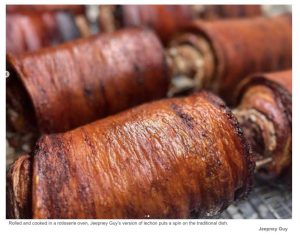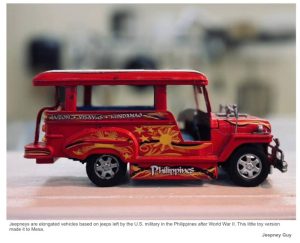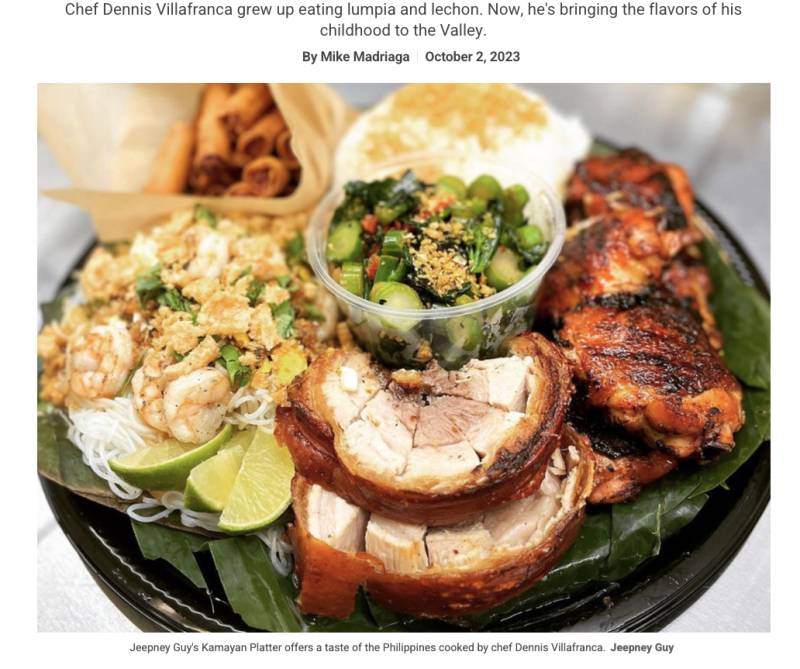Jeepney Guy rolls around the Valley serving flavors of the Philippines
When metro Phoenix residents hear of Filipino food, most think of lumpia, pancit, adobo and lechon — traditional Filipino fare. But chef Dennis Villafranca refers to his creations as atypical, not because he serves obscure dishes from

The original story was published in Phoenix New Times in October 2023.
his family’s homeland of the Philippines, but due to his unique style of cooking.
“Traditionalists comment and say I’m not doing it right because my influences are from living and growing up here in the United States. So my recipes are based on childhood food memories,” he explains. “A lot of times, I don’t remember what the dish was named, but I do remember what it tastes like, and I’ll make it.”
Villafranca runs Jeepney Guy, a pop-up business that serves food at festivals and events around the Valley.
One core image that Villafranca built his brand around is a photo taken when he had just turned one in 1971. In the historical photo, baby Villafranca, his father, two other boys and two additional adults surrounded a 4-foot-long pig roasting over an open fire pit. Lechon is a classic dish usually eaten during celebrations in the Philippines.
In metro Phoenix, Villafranca, now a father himself, cooks lechon his own way.
“I have a special rotisserie oven, and something magical happens in the cooking process,” he says. “It’s self-basting.”
And unlike in the Philippines and other parts of Asia, where the traditional process of roasting a whole pig can take an entire day, “ours cooks for about 3 hours,” Villafranca says.

Rolled and cooked in a rotisserie oven, Jeepney Guy’s version of lechon puts a spin on the traditional dish.
“I get a whole roll of pork belly, which is about 20 inches long and 12 inches across, and I stuff it with a pork loin, season it, and roll it up so it gets crispy skin on the outside when it’s done.” On his menu, the dish is called Pork Belly Lechon.
“It’s similar to Italian porchetta,” he adds. “And it’s been my most popular item as long as Jeepney Guy has been around.”
Family influence throughout the menu
While his father played a pivotal role in the lechon on Jeepney Guy’s menu, Villafranca’s late mother is also represented.
“My dad was in the U.S. Navy, so my mom was home cooking a lot, and her friends used to prepare Filipino food, set up a little table and sell it to the servicemen. The servicemen would go nuts for it because they were so used to eating stuff from the mess halls,” Villafranca recalls.
He would watch and help his mother, Amelia Villafranca, make batches of lumpia. Lumpia are spring rolls made traditionally with ground pork wrapped in super-thin flour wrappers that are then deep-fried to flaky, crispy treats. Villafranca changed it up on his version. Instead of rolling ground pork, he uses minced chicken, onions, carrots and garlic, a recipe he’s perfected over the years.
A focus on festivals
Jeepney Guy started in 2011, and Villafranca moved his business from the San Francisco area to metro Phoenix in late 2021. He opened a location at the AZ International Marketplace in Mesa but later closed to refocus on festivals and events.
“The first festival we served at was the Bao and Dumpling festival in Chandler,” he says. “And the reception from that was overwhelming. Immediately after that, we followed up the Asian District Night Market. We sold out of lechon in an hour and a half, and I had planned for sales to last me four hours.”
The $16 lechon platters are served with garlic rice, braised broccoli greens and tangy lechon sauce. He plans on setting
“We sold out of lumpias fast at the last Asian District Night Market in Mesa,” he says. “They are $8 and come with 10 bite-sized pieces.” For an extra $4, customers can make it a meal with garlic rice and braised broccoli greens.
The Asian District Night Market is a celebration of culture and flavor with food stands, retail vendors, a kids’ zone, an arcade and other entertainment.
“On the last Asian District Night Market, they called it a Kamayan Festival,” Villafranca says. “We did a kamayan platter traditionally on a banana leaf tray. It was a hit, and we ran out of them.”
That night, they served $45 kamayan platters, which each could feed three to five people. The platters were packed with lechon, lumpia, Jasmine rice, tomato and mixed green salad, chicharon and chicken adobo. In Tagalog, which Villafranca speaks fluently, kamayan means to eat with your hands as is traditionally done in the Philippines.
Villafranca’s chicharon, or deep-fried pork skin, is accented with garlic-vinegar seasoning, which makes suitable pulutan, Tagalog for a snack to accompany alcohol. His chicken adobo is cooked in soy sauce, vinegar, and garlic, and is braised and grilled. He adds a fried egg atop the rice, reminiscent of Hawaiian dishes. The plate comes with a side of greens and costs $14.
Representation and appreciation of Filipino food and tradition
Separate from the Asian District Night Market, Villafranca is also looking forward to the Asian Chamber Night Market at the Desert Diamond Casino in Glendale on Oct. 20 and 21. As the holidays approach, the Jeepney gang is also preparing for an influx of long-distance lechon orders.
“I mail many of them to the San Francisco Bay area,” he says. “The furthest I sent one to was Long Island, New York. I’ve always sent to Las Vegas and even Nebraska a few times. And with UPS, it’s amazing how quickly they can send it over, and it’s still fresh. It’s cold vacuum packed and it comes with reheating instructions.”
Villafranca’s business name, Jeepney Guy, is based on memories from when he moved to the Philippines at age 14. He was in awe of the thousands of jeepneys, the most popular mode of public transportation, roaming the streets. They are stretched-out vehicles that are based on military jeeps left by American G.I.s after World War II — then transformed into colorful pieces of art. Some sport dozens of ornate pieces adhered to the body and interior. Like the food Villafranca serves, the jeepneys are tied to the representation of the Filipino community.
“It’s nice to come out here to Mesa and have the Filipinos come out and show support and appreciation,” Villafranca says. “They’re coming out of hiding because we don’t have a home base in metro Phoenix to call our own, like a Filipino town or a Filipino shopping center. But eventually, we’ll get there, and I’d love to be a part of it.”

